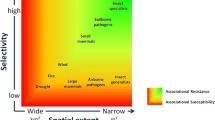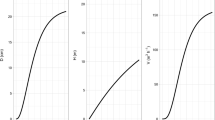Abstract
Lythrum salicaria (purple loosestrife) is an invasive wetland perennial in North America native to Eurasia. Because light environment may limit the species’ distribution, information on the relationship of forest canopy coverage to relative height and seed set in its native environment could give insight into its control in North America. This study examined the effect of various light environments related to forest canopy structure on seed set and stem height in L. salicaria in three biogeographical regions of Turkey spanning latitudes from 36 to 39° N. In Turkey, Lythrum salicaria grows in discrete patches in the canopy gaps of riverine forests, which often are dominated by Populus alba. The mean number of seeds per individual and stem height increased with decreasing canopy coverage (10437±284 to 20652±664 seeds individual−1 and 116±2 to 173±2 cm, respectively). A number of insect seed herbivores were noted on these Turkish populations, most notably a seed predator (Nanophyes marmoratus), which destroyed all seeds in infested capsules. Our study suggested that the light characteristics associated with canopy gaps influenced the seed set and height of L. salicaria. Other factors likely played a role, such as insect herbivores, soil fertility, and competition with other species, which may also be affected by the light levels provided at various levels of canopy coverage.
Similar content being viewed by others
Literature Cited
Ågren, J. 1996. Population size, pollinator limitation, and seed set in the self-incompatible herb Lythrum salicaria. Ecology 77:1779–1790.
Anderson, M. G. 1995. Interactions between Lythrum salicaria and native organisms: a critical review. Environmental Management 19:225–231.
Anderson, N. O. and P. D. Ascher. 1993. Male and female fertility of loosestrife (Lythrum) cultivars. Journal American Society of Horticultural Science 118:851–858.
Arturi, M. F., M. A. Relva, and A. D. Brown. 1999. Leaf consumption of tree species in xeromorphic, temperate forests of eastern Buenos Aires Province, Argentina. Revista Chilena de Historia Natural 72:63–71.
Basset, Y. 1991. The spatial-distribution of herbivory, mines and galls within an Australian rainforest tree. Biotropica 23:271–281.
Blossey, B. 1993. Herbivory below ground and biological weed control: life history of a root-boring weevil on purple loosestrife. Oecologia 94:380–387.
Blossey, B., D. Schroeder, S. D. Hight, and R. A. Malecki. 1994a. Host specificity and environmental impact of two leaf beetles (Galerucella calmariensis and G. pusilla) for biological control of purple loosestrife (Lythrum salicaria). Weed Science 42:134–140.
Blossey, B., D. Schroeder, S. D. Hight, and R. A. Malecki. 1994b. Host specificity and environmental impact of the weevil Hylobius transversovittatus, a biological control agent of purple loosestrife (Lythrum salicaria). Weed Science 42:128–133.
Blossey, B., L. C. Skinner, and J. Taylor. 2001. Impact and management of purple loosestrife (Lythrum salicaria) in North America. Biodiversity and Conservation 10:1787–2001.
Bornette, G., C. Amoros, and N. Lamouroux. 1998. Aquatic plant diversity in riverine wetlands: the role of connectivity. Freshwater Biology 39:267–283.
Cilliers, C. J. 1999. Lysathia n.sp. (Coleoptera: Chrysomelidae), a host-specific beetle for the control of the aquatic weed Myriophyllum aquaticum (Haloragaceae) in South Africa. Hydrobiologia 415:271–276.
Corcket, E., I. Chintaunan-Marguier, R. M. Callaway, and R. Michalet. 2002. Sélectivité et variations environnementales de l’herbivorie par les Orthoptères (Species-dependence and environmental changes in grasshopper herbivory). Comptes Rendus Biologies 325:155–164.
Crone, E. E. and C. G. Jones. 1999. The dynamics of carbon-nutrient balance: effects of cottonwood acclimation to short and long term shade on beetle feeding preferences. Journal of Chemical Ecology 25:635–655.
Davis, P. H. (ed.). 1965. Flora of Turkey and East Aegean Islands, Vol. 1–9, Edinburgh University Press, Edinburgh, Scotland.
Day, R. T., P. A. Keddy, J. McNeill, and T. Carleton. 1988. Fertility and disturbance gradients: A summary model for riverine marsh vegetation. Ecology 69:1044–1054.
Devlet Meteroloji Işleri. 2002. Devlet Meteroloji Işleri Genel Müdürlügü, Ankara, Türkiye (The Turkish State Meteorological Service, Ankara, Turkey).
Dixon, M. D. and W. C. Johnson. 1999. Riparian vegetation along the Middle Snake River, Idaho: zonation, geographical trends, and historical changes. Great Basin Naturalist 59:18–34.
Eckert, C. G., D. Manicacci, and S. C. H. Barrett. 1996. Genetic drift and found effect in native versus introduced populations of an invading plant, Lythrum salicaria (Lythraceae). Evolution 50:1512–1519.
Edwards, K. R., M. S. Adams, and J. Květ. 1995. Invasion history and ecology of Lythrum salicaria in North America. p. 161–180. In P. Pyšek, K. Prach, M. Rejmanek, and M. Wade (eds.) Plant Invasions-General Aspects and Special Problems. Academic Publishing, Amsterdam, The Netherlands.
Edwards, K. R., M. S. Adams, and J. Květ. 1998. Differences between European and American invasive populations of Lythrum salicaria. Applied Vegetation Science 1:267–280.
Flottum, K. 1993. loosing loosestrife. Bee Culture 121:374–378.
Farnsworth, E. J. and E. R. Ellis. 2001. Is purple loosestrife (Lythrum salicaria) an invasive threat to freshwater wetlands? Conflicting evidence from several ecological metrics. Wetlands 21:199–209.
Galatowitsch, S. M., N. O. Anderson, and P. D. Ascher. 1999. Invasiveness in wetland plants in temperate North America. Wetlands 19:733–755.
Grout, J. A., C. D. Levings, and J. S. Richardson. 1997. Decomposition rates of purple loosestrife (Lythrum salicaria) and Lyngbyei’s sedge (Carex lyngbyei) in the Fraser river Estuary. Estuaries 20:96–102.
Hager, H. A. and K. D. McCoy. 1998. The implications of accepting untested hypotheses: a review of the effects of purple loosestrife (Lythrum salicaria) in North America. Biodiversity and Conservation 7:1069–1079.
Hamback, P. A., J. Ågren, and L. Ericson. 2000. Associational resistance: insect damage to purple loosestrife reduced in thickets of sweet gale. Ecology 7:1784–1794.
Harper, J. L. 1977. Population Biology of Plants. Academic Press, London, UK.
Hight, S. D., B. Blossey, J. Laing, and R. Declerck-Floate. 1995. Establishment of insect biological control agents from Europe against Lythrum salicaria in North America. Environmental Entomology 24:967–976.
JMP SAS. 2002. JMP, SAS Institute Inc., Version 5.01. SAS Campus Drive, Cary, NC, USA.
Katovich, E. J. S., D. W. Ragsdale, L. C. Skinner, and R. L. Becker. 2001. Effect of Galerucella ssp. feeding on seed production in purple loosestrife. Weed Science 49:190–194.
Keddy, P., L. H. Fraser, and I. C. Wisheu. 1998. A comparative approach to examine competitive response of 48 wetland plant species. Journal of Vegetation Science 9:777–786.
Keller, B. E. M. 2000. Plant diversity in Lythrum, Phragmites, and Typha marshes, Massachusetts, USA. Wetlands Ecology and Management 8:391–401.
Lemmon, P. E. 1956. A spherical densiometer for estimating forest overstory density. Forest Science 2:314–320.
Levesque, K. R., M. Fortin, and Y. Mauffette. 2002. Temperature and food quality effects on growth, consumption and post-ingestive utilization efficiencies of the forest tent caterpillar Malacosoma disstria (Lepidoptera: Lasiocampidae). Bulletin of Entomological Research 92:127–136.
Louda, S. M. and J. E. Rodman. 1996. Insect herbivory as a major factor in the shade distribution of a native crucifer (Cardamine cordifolia A. Gray, bittercress). Journal of Ecology 84:229–237.
Malecki, R. A., B. Blossey, S. D. Hight, D. Schroeder, L. T. Kok, and J. R. Coulson. 1993. Biological control of purple loosestrife. BioScience 43:680–686.
McCaughey, T. L. and G. R. Stephenson. 2000. Time from flowering to seed viability in purple loosestrife (Lythrum salicaria). Aquatic Botany 66:57–68.
Niesenbaum, R. A. 1993. Light or pollen—seasonal limitation on female reproductive success in the understory shrub Lindera benzoin. Journal of Ecology 81:315–323.
Nyvall, R. 1995. Fungi associated with purple loosestrife (Lythrum salicaria) in Minnesota. Mycologia 87:501–506.
Olsson, K. and J. Ågren. 2002. Latitudinal population differentiation in phenology, life history and flower morphology in the perennial herb Lythrum salicaria. Journal of Evolutionary Biology 15:983–996.
Ottenbreit, K. A. and R. J. Staniforth. 1994. Crossability of naturalized and cultivated Lythrum taxa. Canadian Journal of Botany 72:337–341.
Rachich, J. and R. J. Reader. 1999. An experimental study of wetland invisibility by purple loosestrife (Lythrum salicaria). Canadian Journal of Botany 77:1499–1503.
Reynolds, B. C. and D. A. Crossley. 1997. Spatial variation in herbivory by forest canopy arthropods along an elevation gradient. Environmental Entomology 26:1232–1239.
Shamsi, S. R. A. 1976. Effect of a light-break on the growth and development of Epilobium hirsutum and Lythrum salicaria in short photoperiods. Annals of Botany 40:153–162.
Shamsi, S. R. A. and F. H. Whitehead. 1974. Comparative ecophysiology of Epilobium hirsutum L. and Lythrum salicaria L. Journal of Ecology 62:279–290.
Shipley, B. 2000. Plasticity in relative growth rate and its components following a change in irradiance. Plant Cell and Environment 23:1207–1216.
Stevens, K. J., R. L. Peterson, and G. R. Stephenson. 1997. Vegetative propagation and the tissue involved in lateral spread of Lythrum salicaria. Aquatic Botany 56:11–24.
Stuckey, R. L. 1980. Distributional history of Lythrum salicaria (purple loosestrife) in North America. Bartonia 47:3–20.
Thompson, D., R. Stuckey, and E. B. Thompson. 1987. Spread, impact and control of purple loosestrife (Lythrum salicaria) in North American wetlands. U. S. Department of the Interior Fish and Wildlife Service, Washington, DC, USA.
Treberg, M. A. and B. C. Husband. 1999. Relationship between the abundance of Lythrum salicaria (purple loosestrife) and plant species richness along the Bar River, Canada. Wetlands 19:118–125.
Twolan-Strutt, L. and P. A. Keddy. 1996. Above- and belowground competition intensity in two contrasting wetland plant communities. Ecology 77:259–270.
U.S. Geological Survey. 2003. National Atlas. http://nationalatlas.gov/about.html (accessed July 9, 2003). United States Geological Survey, Reston, VA, USA.
Weihe, P. E. and R. K. Neely. 1997. The effect of shading on competition between purple loosestrife and broad-leaved cattail. Aquatic Botany 59:127–138.
Weiher, E., I. C. Wisheu, P. A. Keddy, and D. R. J. Moore. 1996. Establishment, persistence, and management implications of experimental wetland plant communities. Wetlands 16:208–218.
Welling, C. H. and R. L. Becker. 1990. Seed bank dynamics of Lythrum salicaria L.: Implications for control of this species in North America. Aquatic Botany 38:303–309.
Wenger, E. L, A. Zinke, and K. A. Gutzweiller. 1990. Present situation of the Europe floodplain forests. Forest Ecology and Management 33/34:5–12.
Whitehead, F. H. 1971. Comparative autecology as a guide to plant distribution. p. 167–176. In E. O. Duffey and A. S. Watt (eds.) The Scientific Management of Animal and Plant Communities for Conservation. Eleventh Symposium of the British Ecological Society, Blackwell Scientific, Oxford, UK.
Whitt, M. B., H. H. Prince, and R. R. Cox, Jr. 1999. Avian use of purple loosestrife dominated habitat relative to other vegetation types in a Lake Huron wetland complex. Wilson Bulletin 111:105–114.
Wilcox, D. A. 1995. Wetland and aquatic macrophytes as indicators of anthropogenic hydrological disturbance. Natural Areas Journal 15:240–248.
Willis, A. J. and B. Blossey. 1999. Benign environments do not explain the increased vigour of non-indigenous plants: A cross-continental transplant experiment. Biocontrol-Science-and-Technology 9:567–577.
Author information
Authors and Affiliations
Corresponding author
Rights and permissions
About this article
Cite this article
Ture, C., Bingol, N.A. & Middleton, B.A. Characterization of the habitat of Lythrum salicaria L. in floodplain forests in western Turkey—Effects on stem height and seed production. Wetlands 24, 711–716 (2004). https://doi.org/10.1672/0277-5212(2004)024[0711:COTHOL]2.0.CO;2
Received:
Revised:
Accepted:
Issue Date:
DOI: https://doi.org/10.1672/0277-5212(2004)024[0711:COTHOL]2.0.CO;2




